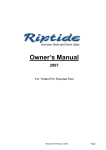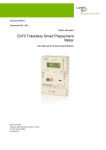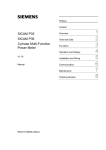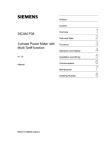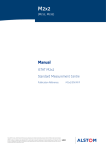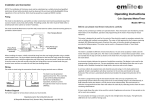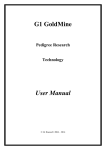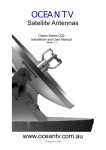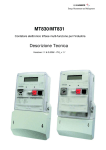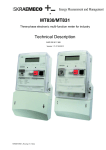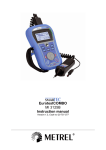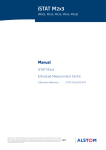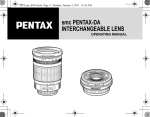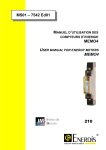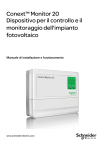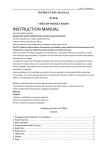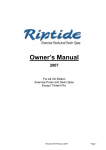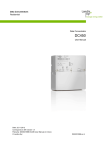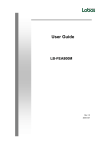Download Manual
Transcript
Electricity Meters Residential BS / IEC British Standard 5219 Polyphase, Multi-Rate TOU Credit Meter User Manual & Technical Specification Date: 20/11/09 Filename: 5219 User Manual Version 4.0.doc Q Pulse Number:IB048 © Landis+Gyr Page 2 of 32 Issue: 4.0 Revision History Revision History Index Date Comments 4 18.11.2008 Revised manual to new branding guidelines and layout Copyright notice The material in this document is the property of Landis+Gyr. Our products are under continual improvement and we reserve the right to make changes without prior notice. Landis+Gyr 1 Lysander Drive, Northfields Industrial Estate, Market Deeping, Peterborough PE6 8FB www.landisgyr.com © Landis+Gyr 5219 Polyphase, Multi-Rate Credit Meter Externally Switched – User Manual & Technical Specification Table of Contents Issue: 4.0 Page 3 of 32 Table of Contents 1 Introduction____________________________________________________________ 5 1.1 Purpose _________________________________________________________________ 5 1.2 Meter Overview ___________________________________________________________ 5 1.3 Reference Standards _______________________________________________________ 5 2 Safety _________________________________________________________________ 6 2.1 Safety Information ________________________________________________________ 6 2.2 Responsibilities ___________________________________________________________ 6 2.3 Safety Regulations _________________________________________________________ 7 3 Operational Functions ___________________________________________________ 8 3.1 Measurement _____________________________________________________________ 8 3.2 Registers ________________________________________________________________ 8 3.3 Reverse / Export Energy Registration __________________________________________ 8 3.3.1 Reverse Energy Detection ___________________________________________________ 8 3.3.2 Import Energy Registration __________________________________________________ 9 3.3.3 Export Energy Registration __________________________________________________ 9 3.3.4 Unidirectional Registration __________________________________________________ 9 3.4 Reactive Energy ___________________________________________________________ 9 3.5 Maximum Demand_________________________________________________________ 9 3.5.1 Rolling Maximum Demand__________________________________________________ 10 3.5.2 Slab Maximum Demand____________________________________________________ 10 3.5.3 Quality of Supply _________________________________________________________ 11 3.6 Phase Indication _________________________________________________________ 11 3.7 Factory / Meter Serial Number ______________________________________________ 11 3.8 Meter Memory ___________________________________________________________ 11 3.9 Anti-creep ______________________________________________________________ 11 3.10 Temperature Range_______________________________________________________ 11 3.11 Power Supply ____________________________________________________________ 12 3.12 Influence of Supply Voltage ________________________________________________ 12 4 Core User Interfaces ___________________________________________________ 13 4.1 Display _________________________________________________________________ 13 4.2 Energy Registration _______________________________________________________ 13 4.3 Optical Interface _________________________________________________________ 13 5 Optional Functions _____________________________________________________ 14 5.1 Introduction _____________________________________________________________ 14 5.2 Pulsed Output ___________________________________________________________ 14 5.3 External Rate Switching ___________________________________________________ 14 5219 Polyphase, Multi-Rate Credit Meter Externally Switched- User Manual & Technical Specification © Landis+Gyr Page 4 of 32 Issue: 4.0 Table of Contents 5.4 No-Power Read _________________________________________________________ 14 5.5 Mode-C Data Readout ____________________________________________________ 15 5.6 Inductive Serial Data Port _________________________________________________ 15 5.7 Calibration Lock _________________________________________________________ 16 5.8 Voltage Isolation Switches _________________________________________________ 16 5.9 Landis+Gyr Switch Mode Power Supply ______________________________________ 16 5.10 Push Button’s ___________________________________________________________ 16 6 Installation ____________________________________________________________ 17 6.1 Construction ____________________________________________________________ 17 6.2 Connections ____________________________________________________________ 17 6.3 Meter Terminals _________________________________________________________ 18 6.4 Sealing Arrangement _____________________________________________________ 19 7 Technical Summary ____________________________________________________ 20 7.1 Technical Facts __________________________________________________________ 20 7.2 Dimensions _____________________________________________________________ 21 8 Maintenance and Service ________________________________________________ 22 8.1 Meter Check ____________________________________________________________ 22 8.2 Meter Testing ___________________________________________________________ 22 8.3 Post Installation Configuration Changes ______________________________________ 22 9 Measures in the Event of Faults __________________________________________ 23 9.1 Operating Faults _________________________________________________________ 23 9.2 Disconnecting the Meter __________________________________________________ 23 9.3 Repairing the Meter ______________________________________________________ 23 10 Decommissioning and Disposal __________________________________________ 25 11 Glossary of Terms and Standards_________________________________________ 26 11.1 Acronyms ______________________________________________________________ 26 11.2 Measurement Units ______________________________________________________ 26 12 Appendices ___________________________________________________________ 27 12.1 Appendix A – Inductive Serial Data Port ______________________________________ 27 12.2 Appendix B – Readout Data ________________________________________________ 28 12.3 Appendix C – Display Options ______________________________________________ 29 12.3.1 Display Examples ________________________________________________________ 30 12.4 Appendix D – Registers ___________________________________________________ 31 © Landis+Gyr 5219 Polyphase, Multi-Rate Credit Meter Externally Switched – User Manual & Technical Specification Introduction 1 Issue: 4.0 Page 5 of 32 Introduction Introducing the 5219 Polyphase meter 1.1 Purpose This manual covers the operation, installation instructions and technical specifications of the 5219 Polyphase credit meter. The 5219 range includes single rate, externally switched multirate, and single or multirate pulse output variants. 1.2 Meter Overview The meter is a whole current credit meter, capable of measuring Active (kWh) (class 1.0) and Reactive energy (KVArh) (class 2.0). The Meter has 3 measuring elements capable of being configured as • 3 phase, 4 wire. • 3 phase, 3 wire. • 2 phases of 3 phase, 4 wire. • Single phase, 2 wire. • Single phase, 3 wire. In some of the above configurations the meters is able to act as a true multi- voltage measurement device, remaining class accurate between 120Vac and 240Vac. (Both limits +15% to –20%) The meter has been given a 20 year certification life by OFGEM, the regulator for the UK. This is based on a reliability of better than 97% over 20 years calculated using an OFGEM model. An LCD display’s all of the meter’s data. 1.3 Reference Standards 1. BS EN62053 – 21:2003 Static meters for active energy. (Classes 1 & 2) 2. BS EN62052 – 11:2003 Alternating current static watt-hour meters for active energy. (Classes 1 & 2) 3. BS5685: 1979: Part 1 Specification class 0.5, 1.0 and 2.0 Single phase and Polyphase, single rate and multi-rate watt-hour meters. 4. IEC62056-21:2002 Data Exchange for Meter Reading, Tariff and Load Control. Direct Local Exchange 5. SI1566: 1998 The Meters (Certification) Regulations 1998; 6. DIN 43 857 Part 2 1978 Principal dimensions for Polyphase Meters Part 4 1974 Principal dimensions of the terminal cover for Polyphase Meters 5219 Polyphase, Multi-Rate Credit Meter Externally Switched– User Manual & Technical Specification © Landis+Gyr Page 6 of 32 Issue: 4.0 2 Safety 2.1 Safety Information Safety Attention is drawn as follows in the individual chapters of this user manual with classified word symbols and pictographs to the relevant danger level, i.e. the severity and probability of any danger: Definition of Danger This symbol is used to indicate a possibly dangerous situation which could result in severe physical injury or a fatality. Definition of Warning This symbol is used to indicate a possibly dangerous situation which could result in minor physical injury or material damage. Definition of Note This symbol is used to indicate general details and other useful information. In addition to the danger level, all safety information also describes the type and source of the danger, it’s possible consequences and measures to counteract the danger. 2.2 Responsibilities The owner of the meter – normally the utility – is responsible that all persons engaged on work with the meter: • Have read and understood the relevant sections of this user manual. • Are sufficiently qualified for the work to be performed. • Strictly observe the safety regulations and the operating information in the individual chapters. In particular, the owner of the meter bears responsibility for the protection of persons, prevention of material damage and the training of personnel (Landis+Gyr. provides training courses for this purpose on specific equipment; please contact the relevant agent if interested). © Landis+Gyr 5219 Polyphase, Multi-Rate Credit Meter Externally Switched – User Manual & Technical Specification Safety 2.3 Issue: 4.0 Page 7 of 32 Safety Regulations The following safety regulations must be observed at all times: • This equipment does not contain a disconnection device. Means for disconnection from the supply must be provided as part of the building installation. Do not work on the equipment unless the supply is disconnected. If disconnection is done by removal of fuses or other cut-outs, the removed disconnection devices must be kept secure from replacement while work is performed. If disconnection is provided by a switch, the switch shall conform to the requirements of IEC 947-1 and IEC 947-3 or equivalent. • This equipment does not contain an over current protection device. Over current protection must be provided as part of the building installation. Maximum over current device rating is 125 Amp at 415 Volts, conforming to the requirements of BS1361, or equivalent. • Only suitably trained and qualified personnel shall be allowed to work on the equipment. Local safety standards shall be observed and shall take precedence over these regulations in points of conflict. • The meter must be held securely during installation. They can cause injuries if dropped. • Any meter that has fallen must not be installed, even if no damage is apparent, but must be returned for testing to the service and repair department responsible (or the manufacturer). Internal damage can result in functional disorders or short-circuits. • The meter must on no account be cleaned with running water or with high-pressure devices. Water penetration can cause shortcircuits. • The meter terminal cover should be secured in place before any load is applied. • To avoid overheating, the meter must be connected using appropriate cable sizes. o Currents up to 60A a cable with minimum 16mm2 cross-section area. o Currents up to 100A a cable with minimum 25mm2 crosssection area. o Currents up to 125A a cable with minimum 35mm2 crosssection area. 5219 Polyphase, Multi-Rate Credit Meter Externally Switched– User Manual & Technical Specification © Landis+Gyr Page 8 of 32 3 Issue: 4.0 Operational Functions Operational Functions The standard operational functions of the 5219 3.1 Measurement The meter has been designed to work with a wide range of voltages, current ranges, and frequency options. Please refer to the technical specifications for details. The meter measures and registers kWh to class 1.0 and KVArh to class 2.0. There is a meter constant LED mounted on the front panel of the meter for testing purposes, pulsing at a rate of 1,000 pulses per kWh. The meter may be configured to register Import and Export energy. See section Reverse / Export Energy Registration. An option is available to ‘enable’ kVArh registration so that meters can be supplied either ‘Active’ only or ‘Active / Reactive’. See section Reactive energy. 3.2 Registers The meter energy registers have the range 000000.000 - 999999.999 kWh. The registers are displayed to a maximum of 2 decimal places unless programmed via the Flag Port (see User Interfaces) to 3 decimal places for testing purposes only. A complete table of registers is shown in the appendix. 3.3 Reverse / Export Energy Registration The meter is able to recognise reverse energy and deal with it according to the configuration requested by the customer. The options include reverse energy detection ‘rEd’, import registration only, unidirectional registration and export energy registration. This configuration is done in the factory. 3.3.1 Reverse Energy Detection The customer may have the meter configured such that when reverse energy is detected the reverse energy warning shown below is displayed. This display will alternate between its normal display and the warning message. This reverse energy power threshold may be set between 0.23 kW and 35 kW, and is calculated over a period of 10 seconds. This threshold is factory configurable and applies irrespective of what forward power may be present during the same period of time. The warning message can only be reset by LANDIS+GYR software or the use of a HHU using the optical communication port on the front of the meter. When clearing down the reverse energy detected ‘rEd message’ and reverse Wh registers, the capacitive kVArh registers will not be affected. 12 34 Figure 1 rEd Message © Landis+Gyr 5219 Polyphase, Multi-Rate Credit Meter Externally Switched – User Manual & Technical Specification Operational Functions Issue: 4.0 Page 9 of 32 The reverse energy detection is available in the registry modes below. 3.3.2 Import Energy Registration In this configuration only forward Watt hours consumed are noted and added to the Total kWh register. 3.3.3 Export Energy Registration The consumption of each phase is added into the reverse or forward registers as appropriate. For example: Phase R 5A forward, Phase S 5A forward, Phase T 10A reverse will result in both forward and reverse registers increasing at the same rate. It will not result in zero power being registered. The impulse LED may be configured to flash when any power is registered, forward or reverse. 3.3.4 Unidirectional Registration The output from each phase will be added directly to the forward registers regardless of the direction of the power. For the example given above the current consumption will be identified as 20A and the impulse LED will flash accordingly. 3.4 Reactive Energy The 5219 can be configured in the factory to measure and register reactive energy. The reactive energy consumed will be registered as inductive or capacitive as appropriate. The Total Reactive energy register can be configured to show the sum of inductive and capacitive reactive energy or the difference between them. The 'Total kVArh' display message will therefore show: Total Inductive kVArh + Total Capacitive kVArh. Or Total Inductive kVArh - Total Capacitive kVArh. 3.5 Maximum Demand Maximum demand may be configured to work in either rolling mode as illustrated below or slab. The maximum demand value in either case may be measured in one of the following, kW, kVAr, or kVA. The MD register has a range 00.00 to 99.99. The meter stores the most previous Total MD value in memory and it may be displayed if required. The meter will measure and display the current MD values assigned to the appropriate rates in the multirate variant. The MD may be reset via the optical port using Landis+Gyr Software or HHU, or front fascia mounted and seal-able MD button. 5219 Polyphase, Multi-Rate Credit Meter Externally Switched– User Manual & Technical Specification © Landis+Gyr Page 10 of 32 Issue: 4.0 Operational Functions The display for maximum demand is shown below. KW is for illustration only and will display as kVAr, kVA etc as appropriate. 1 2 3 KW Figure 2 MD Display 3.5.1 Rolling Maximum Demand Maximum Demand is calculated on a fifteen minute rolling period. Every minute the power usage of the last 15 minutes is calculated and multiplied by four to give the equivalent demand for a one-hour period. If this value is larger than the previous largest stored value, this value replaces it in the Maximum Demand register. Rolling Maximum Demand provides better accuracy than slab MD. As illustrated below the highest demand value will be measured this way, as the peak of demand will be captured by the rolling 15-minute period. Figure 3 Rolling Maximum Demand 10.00 8.00 6.00 kW 4.00 2.00 0.00 1 2 3 4 5 6 7 8 9 101112131415161718192021222324252627282930 Minutes On power up, the MD register will remain at zero until 15 minutes have passed. Maximum demand values will not be calculated until the buffer holds complete data for the preceding 15 minutes. When an MD store occurs (using the MD reset button), MD will remain zeroed until 15 minutes have passed and the buffer holds data for the 15 minutes since the last MD store. 3.5.2 Slab Maximum Demand This maximum demand method works by calculating the maximum demand over fixed customer specifiable periods of minutes. These periods must be factors of 60 minutes. The first period commences on power up of the meter and continues thereafter until power fail or MD reset. © Landis+Gyr 5219 Polyphase, Multi-Rate Credit Meter Externally Switched – User Manual & Technical Specification Operational Functions Issue: 4.0 Page 11 of 32 On powerfail the rising MD value of the current MD period is integrated over the MDP and stored. If this value is larger than the previous largest MD value, on power up the new largest value will become the stored MD value. On MD reset the current MD value is cleared down, and a new MDP started. The value at reset is stored as the most previous MD total. 3.5.3 Quality of Supply The meter may be customer specified to measure and display RMS voltage and current. 3.6 • The Instantaneous Voltage Register has a range 000 to 999 Vac • The Instantaneous Current Register has a range 000 to 999 Amps. Phase Indication The Display will indicate phase voltage present on each phase with the display of the following symbols. Ø1, Ø2, Ø3. The voltage that the symbol appears can be configured at the factory between 0 and 240V. Additionally the phase symbol can be configured to flash to indicate reverse connection or reverse energy detection. 3.7 Factory / Meter Serial Number There is the ability within the meter to store a 46-digit serial number. The most significant 20 digits of which can be laser printed to the meters front fascia. 3.8 Meter Memory All the meters data is recorded in Ferroelectric Random Access Memory (FRAM) under the control of the microprocessor. All the kWh and kVAr registers are stored in the FRAM and will are updated periodically and on power-fail. The FRAM is able to be re-written and is stable (no memory losses) throughout the life of the meter. 3.9 Anti-creep Below starting current, the meter will enter into an anti-creep mode. In this state the meter registration LED is permanently lit and the registers do not increment. The LED remains lit until the meter current is increased in either the forward or reverse direction beyond the starting current. See the technical specification section for details of Ib. 3.10 Temperature Range Operating range: 10°C to 45°C Limit range of operation: 25°C to 60°C Storage range*: 25°C to 70°C *Maximum period of 6 hours at the extremes of this temperature range. 5219 Polyphase, Multi-Rate Credit Meter Externally Switched– User Manual & Technical Specification © Landis+Gyr Page 12 of 32 Issue: 4.0 Operational Functions This complies with IEC 62052-11. 3.11 Power Supply The power supply for the meter electronics is derived from all 3 phases. The meter will continue to operate in the event of a loss of any one or two phases. 3.12 Rated Voltage: 220 / 380 Vac 240 / 415 Vac Operating Voltage Range: +15% to 20% Influence of Supply Voltage The meter complies with IEC 62052-11: Section 7.1.2. and is tested by NMI. © Landis+Gyr Current Range: 5 to125 Amps Frequency: 50Hz Power Burden: Less than 2 watts 5219 Polyphase, Multi-Rate Credit Meter Externally Switched – User Manual & Technical Specification Core User Interfaces 4 Issue: 4.0 Page 13 of 32 Core User Interfaces The inputs and outputs of the 5219 4.1 Display All the meters data is displayed on a LCD on which the size of each value character has a height of 8mm and a width of 3.5mm giving an overall area of 28mm² per character. The LCD has a minimum life expectancy of 20 years. The meter LCD display is designed to have a high angle of readability. The meter shows six significant digits with a customer configurable number of decimal places, 0, 1 or 2. The display cycle advance is factory configurable to be: • An auto cycling system that shows the active rate “flashing” and scrolls through each of the displays according to a configurable time from 1 to 10 seconds. • By using a cycle display button mounted on the meters face. • A combination of both modes. The meter will auto cycle, with the button providing a means of moving to the next display immediately. OBIS display legends are available on request. This is a factory configurable option. See Appendix. A detailed drawing of the LCD is shown below. Further display illustrations are shown in the appendix, along with a table of all available displays. 1 KWh 2 kvarh 3 kVAh 1 vrms 2 Irms 3 RC 4 5 RI Figure 4 LCD Format 4.2 Energy Registration Separate kWh and kVArh indicator LED’s are present on the front aspect of the meter. The pulse value is identified on the meters fascia, at 1000 pulses per kWh/kVArh. The pulses can be used for checking the meter calibration. 4.3 Optical Interface The meter includes a FLAG optical interface based upon IEC6205621:2002. This optical interface supports the IEC1107 mode-c readout protocol. The baud rate for communication via the optical interface can be set in the meter. See technical summary for details. 5219 Polyphase, Multi-Rate Credit Meter Externally Switched– User Manual & Technical Specification © Landis+Gyr Page 14 of 32 5 Issue: 4.0 Optional Functions Optional Functions Optional user interfaces and additional functionality available in the 5219. 5.1 Introduction The features in this section are in addition to the basic 5219 model. These options must be requested when obtaining meter availability and price from Landis+Gyr at the outset of the ordering process. 5.2 Pulsed Output The meter has a pulsed output function, configurable through the optical interface (FLAG) port. The pulse output meets with regulation IEC6205331: 1998 Class B. The output ratings are shown in the technical specification. The meter has the option of one voltage free pulse output for kWh. The pulse output is configurable between 1 to 1000 pulses per kWh, (where 1000/kWh = whole number) with pulse duration of 40 to 500 mS in 20 mS steps. Output format is as shown below; using terminals A and B (figure 6). kWh + _ Figure 5 Pulse Output Format 5.3 External Rate Switching The multi-rate variants are externally rate switched. The active rate is selected externally by applying a signal; neutral or live, to the rate switching inputs. The active rate is dependant on the number of rates the meter is configured for 1, 2, 3, or 4 and the switching protocol the customer has specified. Signal is applied to 1 auxiliary terminal, an alternative auxiliary terminal, or both simultaneously to achieve 4 switched rates. Additionally the meter may be taken with a combination of pulse output and external rate switching. In this circumstance 1 auxiliary terminal is used for rate switching and the meter may only be configured as a 2-rate meter. 5.4 No-Power Read A meter variant is available that addresses the need of some customers to be able to make meter readings while the network voltage is off. A front fascia mounted push button is fitted which when pressed and held for 3 seconds latches the internal power circuit on. This powers the display, © Landis+Gyr 5219 Polyphase, Multi-Rate Credit Meter Externally Switched – User Manual & Technical Specification Optional Functions Issue: 4.0 Page 15 of 32 cycle display button, and optical readout port temporarily and allows a 45 second period to read the registers, via display and or FLAG port readout. After approximately 45 seconds the meter powers off regardless of whether the button is still depressed, and will remain powered off for a period of 45 minutes. This mechanism protects the meters internal power source from being fully discharged by constant button pressing. The displays available during this function are customer specifiable. A secondary back-up power source other than the RTC back-up battery is used for this purpose. 5.5 Mode-C Data Readout IEC1107 readout mode C is available via the optical FLAG port. The enabled functions of the meter such as Export kWh registers, kVArh registers, and maximum demand registers are supported and available within this data stream. The conventions for the data are shown in the appendix. The speed of the data readout is the same as for FLAG communications, that is, 9600 baud. 5.6 Inductive Serial Data Port The meter incorporates an Inductive Serial Data Port that transmits data wirelessly. See table of data in the appendix. This allows meter functionality to be extended at a future date by the addition of an easy to fit add-on module without restricting access to the optical port for the purpose of meter reading. There is no need for a physical connection. Fitting of modules is limited to removing existing terminal cover and replacing with a module, as illustrated below. Figure 6 Additional Modules (Future) The data output provides all information available from within the meter and would support any module including: • Prepayment • Power Line Remote Communication • Radio and Telephone Communication. 5219 Polyphase, Multi-Rate Credit Meter Externally Switched– User Manual & Technical Specification © Landis+Gyr Page 16 of 32 5.7 Issue: 4.0 Optional Functions Calibration Lock If required the meter’s calibration values can be locked with a combination of hardware and software options. A printed circuit board mounted hardware switch is fitted and on completion of the factory manufacturing process this switch is armed by LANDIS+GYR software. FLAG access to the meter memory locations concerned with calibration values, serial number etc are then prevented. The terminal cover and top cover need to be removed for this switch to be reset and access to these locations reinstated. 5.8 Voltage Isolation Switches The requirement during calibration and certification is for voltage and current signals to be isolated from one another. Some customers require this ability also for their own verification testing. After testing is complete and the meter is installed, the ability to do this is prevented by the fitting of a terminal cover and seals. In markets where additional steps are required to prevent non-technical losses, isolation switches may be fitted to the pcb, that once closed prevent any isolation of voltage from current unless the meter seals are broken and the top cover removed. Additionally or alternatively mechanical bungs may be fitted behind the terminal cover that serves the same purpose of preventing isolation of voltage from current. 5.9 Landis+Gyr Switch Mode Power Supply The Landis+Gyr switch mode power supply if fitted allows the 5219 to fulfil the requirement of some markets and local approval bodies for the meter to function with any 1 phase or neutral disconnected. This allows the meter to, with balanced loads, move from 3Phase4wire operation to 3phase3wire automatically with no loss of accuracy. This feature may prove useful in some areas of industry where a provision for neutral connection is left off the local distribution system. 5.10 Push Button’s One front panel push button may be provided if required to enable manual interaction with the display cycle. That is the display list may be read by scrolling through 1 display with each button press. This same push button may also be used to operate the no power read functionality if this option has been fitted. © Landis+Gyr 5219 Polyphase, Multi-Rate Credit Meter Externally Switched – User Manual & Technical Specification Installation 6 Issue: 4.0 Page 17 of 32 Installation Construction, Mounting and wiring of the 5219 6.1 Construction The meter case dimensions conform to the following two standards, BS5685: 1979: Part 1 and DIN 43 857: 1978: Part 2.The terminal cover governed by DIN 43 857: 1974: Part 4. For DIN meters the meter will be supplied with a separate clip-in device to make the design meet the DIN Standard. The Meter has a double insulated case which meets the requirements of BS5685 and is manufactured from the following materials: Base - Flame Retardant Polycarbonate Top – Polycarbonate Window - UV Stabilised Polycarbonate Terminal Cover – Polycarbonate Dimensions follow in the appendix. 6.2 Connections The Meter has 3 measuring elements capable of being configured as: Single phase 2 wire ELEMENT ELEMENT ELEMENT A B C N L1 N L1 SUPPLY LOAD Single phase 3 wire M/E A M/E B M/E C N N L1 A L1 A L1 B SUPPLY 5219 Polyphase, Multi-Rate Credit Meter Externally Switched– User Manual & Technical Specification LOAD L1 B © Landis+Gyr Page 18 of 32 Issue: 4.0 Installation 2 phases of 3 phase 4 wire M/E A M/EB M/E C N L(1,2,3) N L(1,2,3) L(3,1,2) LOAD SUPPLY L(3,1,2) 3 phase 4 wire M/E A M/E B M/E C N L1 L2 L3 N L1 SUPPLY 6.3 LOAD L2 L3 Meter Terminals The main current terminals and auxiliary terminals are manufactured from solid brass to the dimensions and pitch outlined in BS5685: 1979: Part 1 and DIN 43 857: 1978: Part 2. Figure 7 - Terminal Arrangement Photograph Figure 8 - Terminal Arrangement Plan For Pulse Output (P/O) only models: Terminals A and B - pulse output For Externally Switched only models: Terminals A and B - external switches (4 rates) © Landis+Gyr 5219 Polyphase, Multi-Rate Credit Meter Externally Switched – User Manual & Technical Specification Installation Issue: 4.0 Page 19 of 32 For Externally Switched and P/O models: Terminals A and B – pulse output, terminal D – external switch (2 rates). 6.4 Sealing Arrangement The meter is sealed conventionally, using sealing wires and the appropriate seal for the intended market. The meter can be sealed for life if the customer requests this service. 5219 Polyphase, Multi-Rate Credit Meter Externally Switched– User Manual & Technical Specification © Landis+Gyr Page 20 of 32 7 Issue: 4.0 Technical Summary Technical Summary The technical specifications of the 5219 7.1 Technical Facts System Voltage Current (Base) Current (Max) Starting Current Max measuring range Measuring Accuracy Burdens Three element meters Supply variation Direct Connection Ib Imax (IEC) (IEC) Typically 15mA for a balanced load IEC 62053-21 Voltage Circuit @ 230Vac Current Circuit @ Ib Current circuit @ Imax Supply frequency Temperature Range Meter Constant Pulse Output Display Quality OFGEM approval number Certificated life Construction Terminal Arrangement Terminal Diameter Weight Dimensions (mm) Optical interface Baud rate options (baud) IP Rating © Landis+Gyr Frequency variation Limit operating range Storage range The output meets IEC 6205331:1998 Class B LCD 7 segment, 12 segments, Icons for kWh, kVArh, inductive & capacitive reactive power, reverse energy, Irms and Vrms. Manufactured to: (standard terminal cover) (extended terminal cover) (standard terminal cover) (extended terminal cover) FLAG protocol based on standard given above. Communications via optical interface With Short terminal cover With Extended terminal cover 240Vac Phase to Neutral 230Vac Phase to Neutral 220Vac Phase to Neutral 120Vac Phase to Neutral +15% to -20% 5A, 10A, 15A, 20A 80A, 100A, 105A, 120A, 125A. 0.4% of Ib 20mA up to 125A Class 1 Active (kWh) Class 2 & 3 Reactive (kVArh) <2W <10VA <0.5VA <1VA 50Hz, 60Hz ± 5% -25°C to 60°C -25°C to 70°C 1000 imp/kWh Max voltage 24V d.c. Max current 6mA Character size – 8x3.5mm. 6 significant numbers, 2 decimal places ISO 9001:2000 981 20 Years Flame Retardant Polycarbonate, window UV Stablised BS5685 8.3mm 950g 1070g H 175.8 x W 167.9 x D 56.3 H 245 x W 173 x D 58 300, 1200, 4800, 9600 IP51 IP54 5219 Polyphase, Multi-Rate Credit Meter Externally Switched – User Manual & Technical Specification Technical Summary 7.2 Issue: 4.0 Page 21 of 32 Dimensions Figure 9 - Dimensional Drawing of the 5219 Meter 5219 Polyphase, Multi-Rate Credit Meter Externally Switched– User Manual & Technical Specification © Landis+Gyr Page 22 of 32 Issue: 4.0 8 Maintenance and Service 8.1 Meter Check Maintenance and Service While it isn’t necessary, under normal circumstances, to perform any maintenance on the installed meter, the following are check points that should be observed during scheduled periodic meter visits. 8.2 • Is the meter dry and clean, particularly the LCD display and the optical interface? • Does the meter display a legible and sensible display? i.e. does the meter appear in a serviceable condition. • Check all factory fitted and company fitted seals are in place secure and intact. • Observe display for any error messages or notifications • Confirm that the energy registers have changed to a reasonable degree since the last visit. • If irregularities are found, continue as in section 8. Meter Testing The testing of meters, either random sample or on all meters, should be carried out periodically according to national regulations. The meter must be removed as described in section 8.3 and replaced with a meter of similar type for the duration of the tests. 8.3 Post Installation Configuration Changes With the aid of a laptop computer or other suitable hand held device a flag probe and Landis+Gyr specific software, it is possible to amend the factory configured options of the meter. It is beyond the scope of this manual to describe in any further detail the procedure. Landis+Gyr sales team would be happy to discuss specific requirements. © Landis+Gyr 5219 Polyphase, Multi-Rate Credit Meter Externally Switched – User Manual & Technical Specification Measures in the Event of Faults Issue: 4.0 9 Measures in the Event of Faults 9.1 Operating Faults Page 23 of 32 If the LCD window is illegible or the data readout does not function, the following points should be checked. Is the mains voltage present? – Are the preliminary fuses intact? Has the minimum or maximum recommended ambient temperature been exceeded? Is the LCD window clear of all debris? – Not misted over, painted over or soiled in any way. If none of the above are causing the fault the meter should be disconnected as per section 9.2, replaced if required as detailed in section 6 and returned to Landis+Gyr as described in section 9.3. 9.2 Disconnecting the Meter Remove preliminary fuses before continuing The connecting conductors should not be Live when removing the meter. Electrically Live parts are a life threatening hazard. Preliminary fuses should be removed and kept in a safe place until all work is complete, where they cannot be replaced by anyone unnoticed. Proceed as follows: 9.3 • Remove the company seal on the terminal cover (if fitted). • Release the two terminal cover screws and remove terminal cover. • Check with a suitable voltage testing device that the phase connections are not live. If they are live then remove the preliminary fuses and keep in a safe place until all work is complete, where they cannot be replaced by anyone unnoticed. • Remove the signal inputs and outputs by releasing the auxiliary terminal screws. • Remove the phase connections by releasing the main terminal screws. • If required fit a suitable replacement meter as described in section 6. Repairing the Meter There are no user serviceable parts inside the meter. Breaking factory calibration seals will invalidate the calibration status of the meter. In the event of a meter requiring repair, proceed as follows. • Remove the meter from the installation as detailed in section 9.2. • Attach a label, which describes the fault as accurately as possible, to the meter and include name and contact details of person responsible in case of inquiries. 5219 Polyphase, Multi-Rate Credit Meter Externally Switched– User Manual & Technical Specification © Landis+Gyr Page 24 of 32 © Landis+Gyr Issue: 4.0 Measures in the Event of Faults • Package the meter to ensure no further damage can occur during transit. • Send the meter back to Landis+Gyr. 5219 Polyphase, Multi-Rate Credit Meter Externally Switched – User Manual & Technical Specification Decommissioning and Disposal 10 Issue: 4.0 Page 25 of 32 Decommissioning and Disposal The procedure for the safe removal of the meter from the installation is described in section 9.3. Please ensure that ALL SAFETY PRECAUTIONS are met before proceeding. Based on the environmental certificate ISO 14001, the components used to manufacture the meter can, in the main, be broken down into constituent parts and sent for suitable recycling or disposal. The following are general guidelines and should NOT take priority over local disposal and environmental policies which should be adhered to without compromise. Component Parts Printed Circuit Boards LCD Display Metal Components Plastic Components Disposal Treated as per disposal of Electronic Equipment Sorted and delivered to collective recycling point Sorted and delivered for re-granulation if at all possible 5219 Polyphase, Multi-Rate Credit Meter Externally Switched– User Manual & Technical Specification © Landis+Gyr Page 26 of 32 Issue: 4.0 11 Glossary of Terms and Standards 11.1 Acronyms Acronym BS DFS DIN ECD EEPROM IEC ISO LCD LED MD MID NPR OFGEM PTR RED 11.2 Glossary of Terms and Standards Definition British Standard Direct Field Sensor Deutsches Institut für Normung (German Institute For Standardisation) External Connection Diagram Electrically Erasable Programmable Read Only Memory (E2) International Electrotechnical Commission International Standards Organisation Liquid Crystal Display Light Emitting Diode Maximum Demand Metering Industry Directive No Power Read The Office of Gas and Electricity Markets Photo-transistor Reverse Energy Detected Measurement Units A Hz Iref Kg kVAh kvarh kWh mm mO ms Nm o C UN UT V © Landis+Gyr Ampere (unit of current) Hertz (unit of frequency) MID reference current Kilogramme (unit of weight) Kilo Volt Ampere hour kilo Volt Amps reactive hour kilo Watt-hour millimetre (unit of distance) milliohm (unit of resistance) millisecond Newton meter (unit of torque) Degree Celsius (unit of temperature) Rated supply voltage of meter Rated external switch voltage Volt 5219 Polyphase, Multi-Rate Credit Meter Externally Switched – User Manual & Technical Specification Appendices 12 Issue: 4.0 Page 27 of 32 Appendices Additional information for the 5219 12.1 Appendix A – Inductive Serial Data Port The inductive signal is a 26 KHz square wave modulated by the data transmitted at 1200 baud. The stream of bytes representing the data is repeated at 6-second intervals. The table below shows the data available in the transmission. Table 1 Inductive Loop Data Stream Block Description STX character Meter type and hardware version Serial number R1 Import kWh Register (or Total kWh in a single rate meter) R2 Import kWh Register R3 Import kWh Register R4 Import kWh Register R1 Export kWh Register (or Total Export kWh in a single rate meter) R2 Export kWh Register R3 Export kWh Register R4 Export kWh Register R1 Inductive kVArh Register R2 Inductive kVArh Register R3 Inductive kVArh Register R4 Inductive kVArh Register R1 Capacitive kVArh Register R2 Capacitive kVArh Register R3 Capacitive kVArh Register R4 Capacitive kVArh Register Active Rate Customer ID ETX character BCC character Block Byte Count 1 8 20 8 Start of transmission I.e. AMP5219A Most significant 20 digits In Wh 8 8 8 8 In Wh In Wh In Wh In Wh 8 8 8 8 8 8 8 8 8 8 8 2 2 1 1 In Wh In Wh In Wh In Wh In Wh In Wh In Wh In Wh In Wh In Wh In Wh Identification of Configuration file number End of transmission Block check character 5219 Polyphase, Multi-Rate Credit Meter Externally Switched– User Manual & Technical Specification Comment © Landis+Gyr Page 28 of 32 12.2 Issue: 4.0 Appendices Appendix B – Readout Data Table 2 Readout Codes Applicable to the 5219 Code 0.00.6 2.18.1 2.18.2 2.18.3 2.18.4 2.18.0 3.28.1 3.28.2 3.28.3 3.28.4 3.28.0 2.58.1 2.58.2 2.58.3 2.58.4 2.58.0 2.16.1 2.16.2 2.16.3 2.16.4 2.16.0 Definition Serial number Rate 1 kWh register Rate 2 kWh register Rate 3 kWh register Rate 4 kWh register Total kWh register Rate 1 Export kWh register Rate 2 Export kWh register Rate 3 Export kWh register Rate 4 Export kWh register Total Export kWh register Rate 1 Inductive (+kVArh) register Rate 2 Inductive (+kVArh) register Rate 3 Inductive (+kVArh) register Rate 4 Inductive (+kVArh) register Total Inductive (+kVArh) register Rate 1 MD value, rolling or slab Rate 2 MD value, rolling or slab Rate 3 MD value, rolling or slab Rate 4 MD value, rolling or slab Total MD value, rolling or slab This table shows readout codes assigned to date, but these are assigned on an as needed basis and according to customer specifications. Therefore options available are not limited to those in this table. A typical readout may send out the data stream shown in the left hand column of the table below. There would be some variance dependant on customer specific configuration. Table 3 Mode-C Readout Formats Data Stream /AMP55219-0502 0.00.6.0(SAMPLE31) 0.00.6.1(0374132) 2.18.1(000000.00)* 2.18.2(000000.00) 2.18.0(000000.00) 3.28.1(000000.00) 3.28.2(000000.00) 3.28.0(000000.00) 2.58.1(000000.00) 2.58.2(000000.00) 2.58.0(000000.00) 2.16.1(00.00) © Landis+Gyr Explanatory Notes Baud rate (5=9600), hardware (5219) and software issue (0502) Serial number, 16 digits across 2 lines as shown or 9 digits across 1. Rate 1 kWh register Rate 2 kWh register Total kWh register Rate 1 Export kWh register Rate 2 Export kWh register Total Export kWh register Rate 1 Inductive (+kVArh) register Rate 2 Inductive (+kVArh) register Total Inductive (+kVArh) register a Rate 1 MD value 5219 Polyphase, Multi-Rate Credit Meter Externally Switched – User Manual & Technical Specification Appendices Issue: 4.0 Data Stream 2.16.2(00.00) 2.16.0(00.00)!8 Page 29 of 32 Explanatory Notes Rate 2 MD value Total MD value and sign off checksum *N.B All registers (000000.00) are shown here with no kWh/kVArh values. 12.3 Appendix C – Display Options Table4 Available Displays in the 5219 Description of available displays Software Version Hardware variant / software options Display Test Total Import kWh Rate 1 Import kWh Rate 2 Import kWh Rate 3 Import kWh Rate 4 Import kWh Active Rate Import kWh Total Export kWh Rate 1 Export kWh Rate 2 Export kWh Rate 3 Export kWh Rate 4 Export kWh Active Rate Export kWh Total Sum/Difference kVArh Rate 1 Sum/Difference kVArh Rate 2 Sum/Difference kVArh Rate 3 Sum/Difference kVArh Rate 4 Sum/Difference kVArh Active Rate Sum./Difference kVArh Total Inductive kVArh Rate 1 Inductive kVArh Rate 2 Inductive kVArh Rate 3 Inductive kVArh Rate 4 Inductive kVArh Active Rate Inductive kVArh Total Capacitive kVArh Rate 1 Capacitive kVArh Rate 2 Capacitive kVArh Rate 3 Capacitive kVArh Rate 4 Capacitive kVArh Active Rate Capacitive kVArh Total Maximum Demand R1 Maximum Demand R2 Maximum Demand R3 Maximum Demand R4 Maximum Demand Previous Total Maximum Demand Cumulative Maximum Demand Maximum Demand Reset Count 5219 Polyphase, Multi-Rate Credit Meter Externally Switched– User Manual & Technical Specification © Landis+Gyr Page 30 of 32 Issue: 4.0 Appendices Description of available displays Phase 1 Vrms Phase 2 Vrms Phase 3 Vrms Phase 1 Irms Phase 2 Irms Phase 3 Irms Table 5 Alternative OBIS Displays Obis Code 01 20 21 22 23 81 82 83 84 Register MD reset count Total Import kWh Total Export kWh Total Inductive (or sum of L+C) kVArh Total Capacitive kVArh R1 Import kWh R2 Import kWh R3 Import kWh R4 Import kWh 12.3.1 Display Examples The examples below show the symbols used for the various registers. 1 2 3 KWh Figure 10 Total kWh 1 2 3 KWh Figure 11 Total Export kWh 1 2 3 KWh Figure 12 Total Export kWh alternative display © Landis+Gyr 5219 Polyphase, Multi-Rate Credit Meter Externally Switched – User Manual & Technical Specification Appendices Issue: 4.0 1 2 Page 31 of 32 3 KVArh Figure 13 Total Sum or Difference kVArh 1 2 3 KVArh RI Figure 14 Total Inductive kVArh 1 2 3 KVArh RC Figure 15 Total Capacitive kVArh 12.4 Appendix D – Registers Table 6 Potential Registers available in the 5219 Potential Registers Total Import kWh Rate 1 Import kWh* Rate 2 Import kWh Rate 3 Import kWh Rate 4 Import kWh Total Export kWh Rate 1 Export kWh Rate 2 Export kWh Rate 3 Export kWh Rate 4 Export kWh Total Sum/Difference kVArh Rate 1 Sum/Difference kVArh Rate 2 Sum/Difference kVArh Rate 3 Sum/Difference kVArh Rate 4 Sum/Difference kVArh Total Inductive kVArh Rate 1 Inductive kVArh Rate 2 Inductive kVArh 5219 Polyphase, Multi-Rate Credit Meter Externally Switched– User Manual & Technical Specification © Landis+Gyr Page 32 of 32 Issue: 4.0 Appendices Potential Registers Rate 3 Inductive kVArh Rate 4 Inductive kVArh Total Capacitive kVArh Rate 1 Capacitive kVArh Rate 2 Capacitive kVArh Rate 3 Capacitive kVArh Rate 4 Capacitive kVArh Total Maximum Demand R1 Maximum Demand R2 Maximum Demand R3 Maximum Demand R4 Maximum Demand Previous Total Maximum Demand Cumulative Maximum Demand *N.B Actual register combinations depends upon meter variant used Top of the Document © Landis+Gyr 5219 Polyphase, Multi-Rate Credit Meter Externally Switched – User Manual & Technical Specification
































